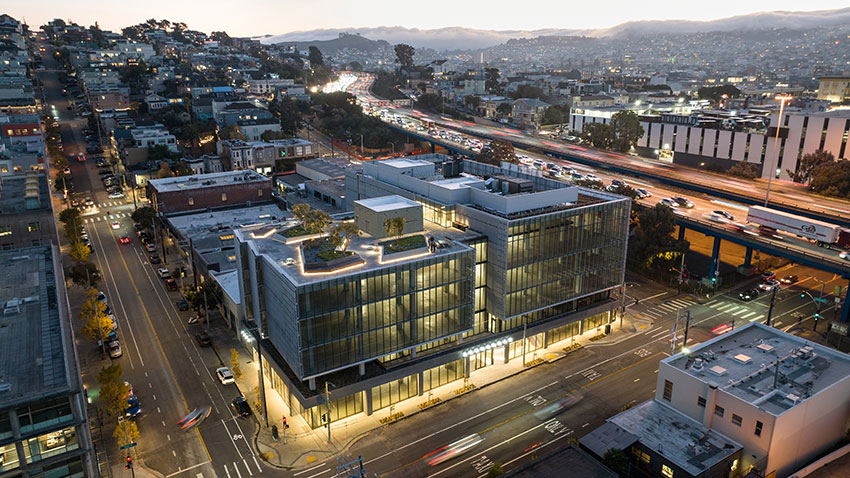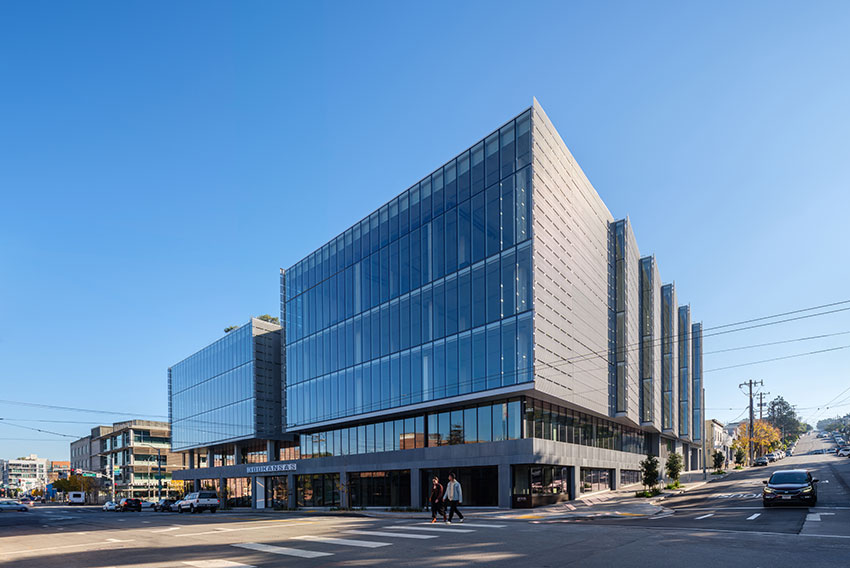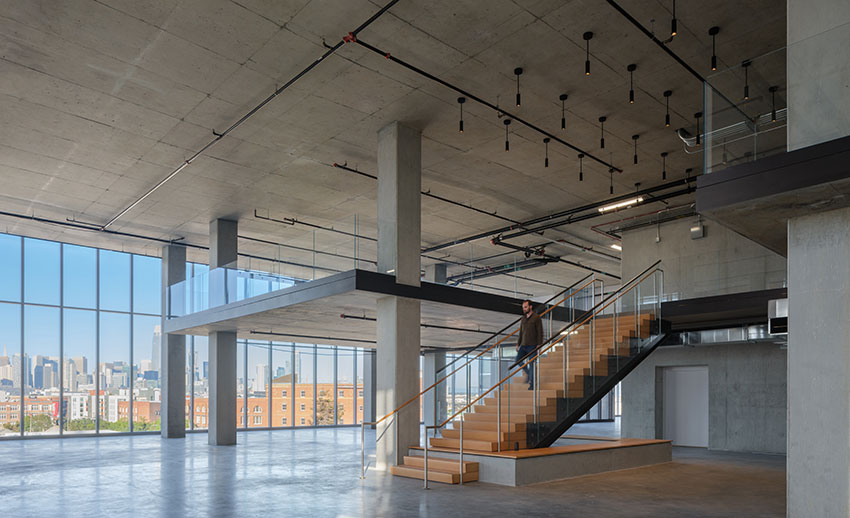Longevity and Sustainability of Curtain Walls
Potrero Hill Innovation Center, San Francisco (300 Kansas): Facades Tailored to a Unique Industrial Space

Photo: Jason O’Rear; courtesy of El Dorado Architects
Figure 5. Potrero Hill Innovation Center viewed from northeast, adjacent to Interstate 80 in San Francisco.
In San Francisco’s design district, on a site between two busy thoroughfares (U.S. 101 to the immediate west and Interstate 280 a few blocks east), a developer has placed an optimistic bet on a midrise building relying on a bold, site-sensitive facade to attract the kinds of light-manufacturing tenants that may return the Bay Area to the forward edge of the national economy. Local colleagues of the out-of-town architects have commented that the 150,000-square-foot, six-story Potrero Hill Innovation Center (Fig. 5) “really feels like it’s a San Francisco building, which is a great compliment,” says David Dowell, AIA, partner at El Dorado, a firm based in Kansas City, Mo., and Portland, Ore.
The specific San Franciscan-ness “starts with the bay window,” Dowell says; in that city, whose bay-window ordinance allows architects to build out over a property line, “the bay window is the iconic architectural feature, historically, and so the building’s playing an instrument in that symphony.” The Innovation Center takes its identity from “the composite detailing of the east and west facades,” he continues: “the storefront, the curtain wall, and then a system of solid and perforated corrugated metal and openings on either side calibrated to cardinal orientation.” The south facade is opaque for thermal control; the north facade is all curtain wall. The east and west facades, “curtain wall with scrim on the outside,” take a familiar light-catching industrial form, the sawtooth roof, and flip it 90 degrees to place the “sawtooth bays” in the facades’ vertical dimension, the elegantly simple result of El Dorado’s strategic thinking about glazing orientation to solar views (Fig. 6).

Photo: Jason O’Rear; courtesy of El Dorado Architects
Figure 6. North and west facades of Potrero Hill Innovation Center, showing sawtooth bay windows on the west.
“What that does is, it creates these light wells that penetrate deeper into multiple floor plates, as opposed to a singular plate of a mid-century factory building in Anywhere, USA,” says project architect John Renner. “It allows for a semi-lit, semi-shielding facade, especially on the sides, where it’s necessary with the immediate highway next door.” The perforated corrugated metal on those east and west sides also aids in compliance with the state’s tough CALGreen standards for Sound Transmission Class (STC) levels; building massing is higher on the noisier highway (west) side. “By taking the sawtooth onto the side of the building,” Dowell adds, “it opened up the possibility to put a park on the roof; there’s a lavishly appointed park for the tenants up on the roof of the building, where the sawtooth would typically go. There were all these opportunities to take a typology from another era and manipulate it based on context and environment.”
“This is the first all-electric zero-carbon manufacturing core-and-shell building in San Francisco in at least one if not two generations,” Dowell adds. Working with an all-star team including environmental design consultants Atelier Ten, structural engineer KPFF, acousticians Salter and Associates, and contractor Webcor, the El Dorado team navigated San Francisco’s often byzantine permitting process (the project began in 2017) with two main points in its favor: LEED Gold-level energy-performance metrics to meet San Francisco’s guidelines for envelope design, and a program that fits the highly coveted local zoning category termed Production, Distribution and Repair (PDR). “The city expressed strong feelings that they don’t want any of it going away,” Renner recalls. “At one point, we even did a study of [possible rezoning for housing], and the city straight-up said, ‘No, we can’t; we don’t want to lose any of our PDR stock.’ So having new PDR is a win/win.” Considering the other typologies that recent local market forces have over-incentivized, Dowell adds, “the city was really enthusiastic about something that was not high-end residential and was not a tech office.”
Atelier Ten’s Emilie Hagen comments that “the North facade did the heavy lifting for views and daylight; East and West contributed selectively, while the opacity of the South made it high-performance from an energy standpoint.” In allocating performance metrics to the facade and other components, she says, “for embodied carbon, we were working towards project-level goals of keeping total embodied carbon below 500 kg CO2 equivalent per square meter and reducing 10 percent from a baseline. We had the concrete in the structure do most of the work by optimizing mix designs to reduce cement (and thereby embodied carbon) and going for cleaner rebar, meaning the facade didn’t need to be modified in support of this goal.” Renner adds that attention to site orientation and daylight (Fig. 7) “helps limit the need for an over-designed or highly energy-consumptive MEP system.”

Photo: Jason O’Rear; courtesy of El Dorado Architects
Figure 7. Interior view, Potrero Hill Innovation Center.
Dowell notes that the building’s design facilitates curtain-wall maintenance. “There was thoughtful attention given to cleaning, which also means if you can clean the facades, you can also get to them and service the sealants. And if there’s a problem, you have a system built all the way around the building, including an occupied roof, where you can get to everything but the south-facing wall that abuts the other properties. So the conditions are set for caring for the building appropriately to extend the longevity.”
Tenants are not yet in place for the Innovation Center at this writing, though Renner describes the facility as flexible enough to accommodate “3D printing, R&D, heavy CNC machines that need sensitive calibration to do work on these floor slabs, or heavy exhaust systems required for lab work.” Developer Spear Street Capital also reportedly has its eye on firms working on robotics or autonomous vehicles as potential tenants—the kind of industries capable of returning vigor to this troubled, beautiful city’s employment profile.









